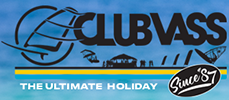“ PETER HART – MOVING FORWARDS! ”
Words Peter Hart // Photos C/O Hart Photography unless noted.
Originally published within the April ’17 edition.
In part 2 of his ‘learn to loop’ story, Harty describes how the triumphant first rotation and scrambled waterstart should only be the beginning of a long and joyous journey.
Gerard Kelly taught himself to loop in his late forties. He’s a frequent visitor to Pozo in Gran Canaria, the looping capital of the world; and it was there, after a week of mental and physical preparation, that he nailed his first one. Gerard is a natural risk-taking, former Gaelic footballer player hewn from the stone of his native Donegal. Given that it was 3.7 weather (even for 90 kg Gerard), there was a hint of a suggestion that these first loops may have been a little agricultural. Being an affable Irishman, he quickly made friends in Pozo, two of which were the Jensen brothers Vidar and Orjan, long term residents of GC and both iconic wave sailors and loopers. Keen to get some feedback, he cornered Orjan. This is how he describes the conversation.
“I asked him if he’d seen my loop(s) and what he thought. He went: ‘ah yes Gerard … well … it’s a loop … sort of … but not really. How can I put it? Looping is a big book. You’ve read the introduction and a few lines of chapter one … but there are many, many more chapters left.’” Gerard took it on the chin. He absolutely understood the analogy and realised he had to approach the next stage in the same way as he had gybing. On his gybing journey from habitually stacking his Mistral Screamer on the flat waters of Tarifa in the early 90s, to cranking his wave board around with style and consistency in the chop and swells of the N. Atlantic, he learned instinctively to adjust pressures through rig and rail at high speed to compensate for all manner of inconsistencies; and most importantly he went from being totally ‘where the hell am I?’ disorientated, to knowing exactly where he was at all stages of the gybe – and thus able to vary the arc and timings of rig and foot changes to ensure a clean, speedy exit.
The looping journey is similar. Beginners have just one loop – experts have a selection. The fact that the latter land dry whether spinning off flat water in 18 knots or stalling one from 30 feet in 45 knots, reveals they too know where they are and have the tools to control every stage. The aim with all moves is to widen your potential window for success from a slit to double French doors.
So what are we looking at?
The ESSENCE of BRILLIANCE
Here are three things that distinguish a good loop from an average one. Time. People always say of experts, how much time they seem to have and never more so than when looping. Ironically it’s because they’re going faster. Speed translates into height, which gives them time to pause and rotate. Time is also a function of space – you won’t see them hugging the rig. By maintaining distance they have the freedom to make adjustments …
Adjustments. The beginner looper appears to do just one thing – sheet in on take off – after which they freeze, shut their eyes, roll and hope for the best. The expert makes adjustments all the time to control the rotation.
Tempo and Dynamism. This is it. Bottom turn, gybe or loop – what turns heads is the explosiveness of the move, which comes from the sudden powering up of the rig. It’s going from sheeted out to suddenly sheeted in that gouges the rail or gets the board whipping through the air. A beginner loop slows down as it goes round – an expert one speeds up. It’s the speed of the rotation which is so impressive – and which leads to a satisfactory, dry ending.
THE DEVIL is in the DETAIL.
Two mast mount shots look pretty similar but the top one ends with a back crash while the bottom one enjoys a clean landing. On the top shot there’s an accumulation of minor sins.
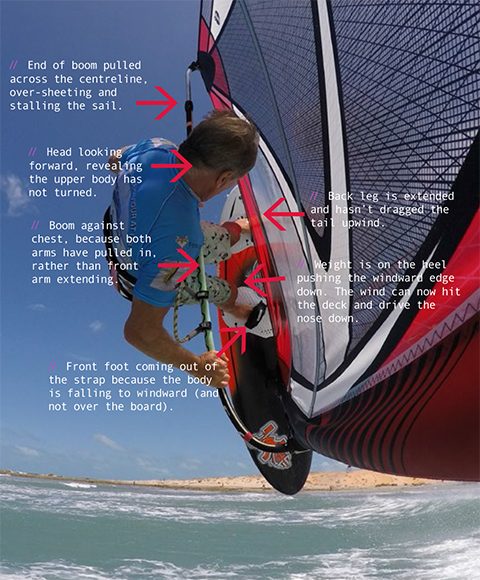
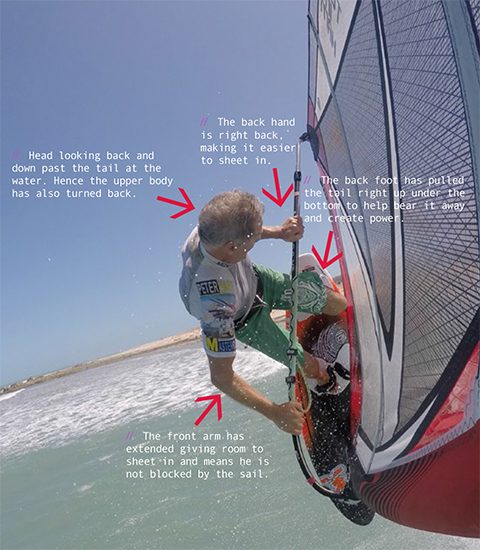
THE NEXT LOOPING LEVEL
Looper … or someone who once did a loop?
You’re euphoric and exhausted beyond belief after a successful summit of Everest. Your guide enters the tent and follows ‘well done’ with the pronouncement that actually you were a bit rubbish and that tomorrow you go again – but this time at twice the speed and carrying your own bags. With the one finger that wasn’t frostbitten you would surely poke him in both eyes before heading straight down to sea level muttering “I’m not addicted to pain and only ever intended to tick that box once.” The loop differs from many moves in that the mere completion of one represents such a milestone that the prospect of continuing with the beatings isn’t immediately so attractive.
There is a decision to be made. Do you want to be a recognised looper … or just someone who once did a loop? Looping only once gives rise to false assumptions.
• You’ve done one so can surely do another whenever you like. You can’t. It’s possible to fluke a loop. The stars may align. Just as it’s possible to survive a gybe leaning back with straight legs and bent arms, you can get round a loop in horrible shape. Without cute technique, it’s not readily repeatable.
• ‘Because you’ve done one, you’ve broken the fear barrier.’ Temporarily maybe
• but if you leave it, you quickly return to that original state of ‘Nervous Nelly’
• and basically have to start again.
The fear issue, I’m sorry to say, never really goes away – but then nor does it with most aspects of advanced windsurfing.
The carve gyber progressing from floating one round under-powered on flat water to dropping into a lay-down over crazy chop at 30 knots, stacked on edgy slalom kit …
The wave sailor going from ‘slishing and a-slashing’ in 2 foot mush, to bottom turning towards a hollow mast high swell in a 30 knot offshore breeze…
The looper going from rumbling over into the waterstart position, to popping off a head high ramp, stalling and then pulling on the power to whirl into a dry rotation …
They are all having to re-confront that same issue that scared the poop out of them when they were rookies – the fear of a catapult. And in every case, improvement comes from embracing more speed and power through developing slicker and more instinctive rig control.
“ Under rotating and having your backside penetrate the water first and cushion the impact, although uncomfortable, is strangely reassuring.
But trust me, landing dry is SO much better. ”
The Improvement Path
Loops are no different from many advanced other moves in that it’s all too easy to plateau. There is a comfort zone to be found in simple survival. People slow down in gybes so they perform the ‘dangerous’ rig and foot change off the plane where errors will be less severely punished.
Ironically in the loop, the ‘comfort zone’ is landing on your back and buttocks – sore but somehow better than jarring ankles from over-rotating and slamming down over a flat board. The majority of bad looping habits are born out of timid defensiveness. You prefer a slow crash to a fast one, hence you instinctively stay close to the wind, avoid the power zone, under-rotate and waterstart away.
Like a planing gybe or a light wind waterstart, success comes from making every stage more precise and powerful.
I keep mentioning these other moves because the loop is just that, another windsurfing move, with so many shared elements. It’s not an out and out there acrobatic stunt.
In dynamic moves that are done and dusted in a few seconds, if they don’t start well, they rarely get better half way through. So when it comes to improving rotation, the beginning is a very good place to start.
Approach and the speed question – fast is good.
Under-rotating is more often than not down to lack of speed.
You may remember this quote from carve gybe advice. “The right speed to enter the move initially feels way too fast.” It’s the same with the loop. More speed surely means a harder impact. Rethink. Less speed guarantees a flop.
It’s simple physics. If you’re sprinting and trip over a log, your legs stop but your top half keeps on going and over you go into an involuntary forward somersault. The faster you’re going when you trip the more sensational the somersault.
So as you hit the wave full tilt, think of your upper half projecting forward and tripping over your feet.
“ Most amateur loopers under-rotate because they don’t bear away enough before sheeting in.
The board should be pointing dead downwind before you pull the trigger. ”
CASE 1. Slow … then Speedy Sam.
Sam told me he’d done a loop in the summer. I met him in October and he’d failed to repeat it. He did a few in front of me and made it half way round, flopping onto his back under the sail. He was going way too slow. His problem was his sailing line in the cross on conditions. He would head up to try and hit every wave, even the small inside waves, head on. But it meant he never hit them at speed. These were the tips and strategies that changed him.
• I told him that unless the wave was big and dumping, he didn’t have to change his line. It’s fine to stay across the wind and hit the waves diagonally. As the wave approaches I said do nothing more than press on the toes to lift the windward edge and let the wave pass underneath.
• The tip that made the biggest change when I told him was ‘to look downwind, not upwind, for a ramp’, which of course made him bear away and accelerate towards it.
Approach – bear away … but not too far.
‘Bear away’ towards the wave has become a loop mantra. Take off upwind and you get blocked by the sail and have no choice but to dive over it ‘cheese roll’ style. For many, their first sniff of success came when they took off downwind with a powered up sail and, oblivious to all subtleties, just got heaved around.
But now that ‘bear away’ advice needs to be qualified.
Charging at a lipping wave on a broad reach you have very little control on take-off (but deep respect for trying). There’s too much power, you can’t sheet out – so as soon as the nose leaves the lip and is unsupported by water, the mfp drives it straight down. If you do make the loop it will be a kind of low,
rolling crash.
You have to hit the wave across the wind. Across the wind you have the most control.
The bear away comes as you leave the wave. The first priority is to get the nose UP.
NOSE UP … NOT DOWN
Early loop misinformation included the notion that you took off and then deliberately stuck the nose in the water and pivoted around it. In speed loops especially, the nose may touch the water and bounce off it – but that’s not the idea, and in the good ones it clears it.
Top Tip alert. The number one reason for under-rotation is sheeting in too soon – before the board has borne away or, in extreme cases, before it’s even left the water. If the nose drops and catches the water across the wind, you’ll get slammed on your side. If you keep pulling, you may just scramble a waterstart … but usually not.
The higher you get the nose, the more room the board has to rotate – and the further off the wind you are when you sheet in, the less far you have to rotate.
But how?
Bearing away – let the wind do the work.
Under-rotation comes primarily from the rig not producing enough force.
Take it back a step and imagine what you do to plane. What releases the board is a burst of power gained from bearing away suddenly from tight to broad reach.
Bearing away on take-off comes from doing two things.
• Releasing the nose.
• Lifting the windward edge so the wind can get under the released nose and blow it downwind.
Release the nose
The next time you’re admiring jumps on YouTube, freeze the action (preferably of the pros) the microsecond before take off and you will see a common theme – they’ve all bent their front arm to sheet out and release mastfoot pressure. Then the lip of the wave can smack the nose and direct it upwards.
CASE 2 – Adam, submarine man. Back to jumping basics.
Adam’s were the strangest loops I’d ever seen. The committee even had to retire to consult on whether or not they counted. A loop surely has to contain an aerial element. It was debatable whether Adam, at any stage, left the water. He would do a hop, land – and it was the board touching back down that was his trigger to pull and look back. Incredibly, thanks to tenacity, a very firm grip and builder’s strength, the board often squirted all the way round. He’d got so transfixed by the rotation bit that the jump phase had been completely forgotten. Like all moves, when in habitual trouble, return to basics – in this case some fast, speedy jumps – and build it back up from there.
Toes down, windward edge up
Under rotation and that horrible feeling of prematurely nose-diving and slamming, is so often down to board angle. If you hesitate or get momentarily defensive, you fall back and weight the heels. As the windward edge drops on take off, the wind hits the deck and drives the board straight back down. You have to take off from your toes. For a start you get more spring – but more importantly, you lift the windward edge, present the underside to the wind, which then drives the nose off downwind. The toes must stay down all the way round.
Here’s the sequence.
Sheet in as you approach the wave, sheet out as you climb the face to release the nose and at the same time drop the toes.
Wait for the wind to blow the nose downwind before picking up the tail and sheeting in again (by straightening the front arm) to power up and rotate.
CASE 3 – Toes down Dan.
In certain instances, a training method that helps conquer one element can also breed a bad habit. Dan was a habitual ¾ looper. Great rig action but very little pop and fly. His training method had been to focus on the late slam gybe – scooping the rig to windward as he approached the wave, sheeting in as he flopped off the top, getting mfp to drive the nose downwind, getting the feeling of him being at the centre and the kit rotating about him, rather than him diving over the mast tip.
But he was so intent on pushing the rig to windward that he would drop back onto his heels as he took off. The wind never got under the board, so he never got any height and the nose would dive.
All I said to him was ‘toes down all the way round’ and the next one was dry.
More power to your rotation
When things are basically going right but butt-slaps are becoming an accepted part of the move, succour comes from tweaking the rig action.
Coming up, two tips for getting more whip and power out of the rig during the critical sheeting in stage.
1. Front hand back. The further you move your front hand back towards the harness line, the further forward you can throw the rig and the more you power up the front of the sail. It’s the first adjustment you make to help planing. It places you on the edge of a catapult – the loop IS a catapult. If you slide it right back just as you take off, it’s impossible to stop the sail powering you up and taking you round.
2. The secondary back hand movement. It happens (should happen) in duck gybes, carve gybes and in loops.
THE BACK HAND. Move it back – and then again.
A sure sign that you are reaching a new level of looping control is when you have the presence of mind to move the back hand back as you approach the wave …and then move it back yet further when you throw the rig forwards to initiate the rotation. If the back hand stays in the middle of the boom, you don’t gain the leverage to sheet in and get blocked by the sail. The main problem with so much going on, is just remembering to do it. One of the advantages of going higher (there don’t appear to be many early on) and in delaying the rotation, is that you buy a bit of time to think of these things. In the sequence below, Pedro de Souza was about 24 feet up when he slid the back hand back again. There’s much to be admired in the sequence below.

The body is compact. The tail has pulled right up under the bottom to bearaway; and the toes are down so the wind can flow under and support the board.
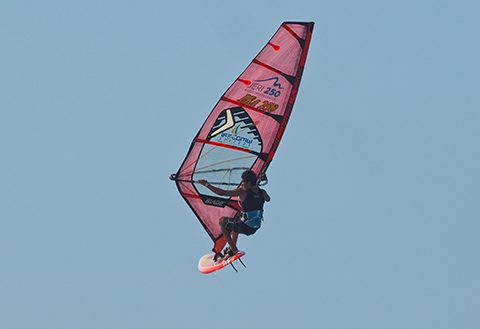
He pushes the rig across to windward, and that allows him to move the hand back – well not just back … right back.

He turns his head back and sheets in. Leaving the front arm extended – note the board angle, still windward edge up.

He keeps pulling and stays compact…
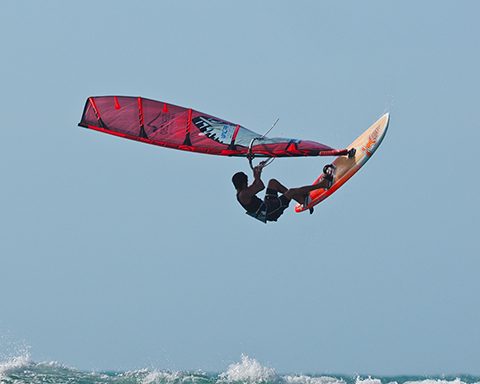
…and when he sees the landing, he prepares for a powered up landing by extending the arms. Note through most of the rotation he has been under the sail … not diving over it.
“ Most amateur loopers under-rotate because they don’t bear away enough before sheeting in. The board should be pointing dead downwind before you pull the trigger. ”
In all those moves, you slide the back hand down the boom before you unhook, bear away and take-off – to give you more leverage to sheet in. But you can only get it so far down without leaning back and corrupting your stance. But then as you push the rig forward to initiate the turn or loop, you can move it back further. But with so much going on, it’s really hard to remember – and yet it makes an immediate difference. The back hand should be relatively near to the clew. From there you can power up with a little finger.
Tucking up, vision – and the twisting back foot.
Those struggling with clean loops sometimes just have to change the way they use the straps. There is information out there that states that you pull the board round with your feet. You don’t – in fact you can’t. Those who try, curl the toes up to grip the straps, thereby pulling the windward edge down … and we saw what happened then.
As you get better, you use the straps less and less – and realise that the feet actually do very little – but what they do do, is crucial.
On take off (toes down) and just as you throw the rig forward, you pick the tail up by dragging your toes up under your backside. That along with the wind blowing the nose downwind, bears you away.
When you get good at this and find yourself with the presence of mind to consider minutiae, a detail that has helped many is to twist the back foot back – i.e. try and point the toes at the tail. That small twist of the foot makes you rotate hips and shoulders back and makes you sheet in.
Landing part 1 – the vision.
Landing should not be a surprise. If it is a surprise, then either your eyes are closed or you are looking in the wrong place. You have heard ad infinitum how important the head is for leading the body into good positions – and never more so than now. It is pretty much impossible to sheet in and rotate the body back if you’re staring at the nose. (If you can, the flexibility of your neck is to be admired.)
To initiate rotation, either look at the time you did your perfect loop (assuming your watch is on the wrist of your back hand) – or better still, look down at your back foot. (This is one of the few times in windsurfing you can legally stare at a foot). Past your back foot you will see the water and your landing area. As sea turns to sky, turn the head to look forward and you’ll see the water again and so anticipate the landing.
ARE YOU A NOSE DIGGER?
Some deliberately shove the nose in the water and try to catapult around it – wrong! If the nose digs in across the wind, the board stops rotating and you get slammed. The aim is to get the nose as high as possible to give you room to rotate.
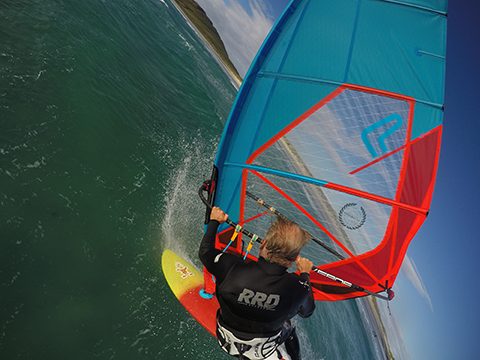
The nose may touch the water on the way round, but it’s better if it doesn’t.
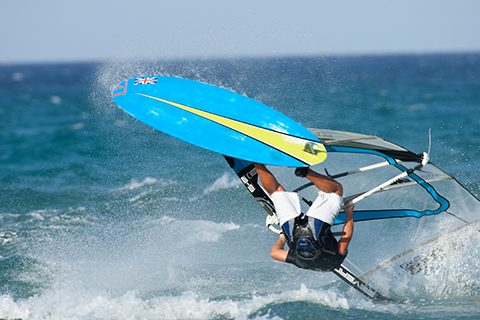
Dave White speed looping in Fuerte. As an incentive to rotate more and land cleanly, we went out just in rashies and shorts (i.e. no butt or back protection). Slamming in your bare back at 30 knots smarts a bit.
POWER ON LANDING – opening out.
One of the commonest ways to stall a regular jump is to fall back against the rig and over-sheet on landing. It’s the same with the loop. People sheet in on take off (good) but stay sheeted in. The more you rotate, the broader you land to the wind. Well orientated loopers are aware of this and open the sail in anticipation of landing and a powerful exit.
Staying small
You see it off the springboard at your local baths. Hero Dwayne tucks into a somersault but then straightens out too soon, whereupon the rotation slows down and he lands square on his back.
There is a syndrome that happens with keen but reticent jumpers. The moment they take off, they turn into a starfish – legs pinging straight down hoping to feel immediately the security of board against water, rather than making like a ball and luxuriating in the sensation of soaring. Reluctant loopers do the same. Afraid of rotating too far, they do the opposite of ‘tucking’ – thereby ensuring another slap on the back.
If you want to complete a dry loop, tuck up… and then tuck up some more – I mean really squidge. The smaller you make yourself, the faster you rotate. But if you’re still afraid of over rotating be reassured that the right amount of rotation feels like over-rotation to begin with. I recall so well my first proper standing-up, dry one. The internal monologue went something like … “When is this whirling going to stop? I’ve definitely over-cooked it this time … how long do smashed femurs take to heal? Sploosh! Oh … I seem to be feeling fine and heading fast in the same direction.”
HARTY – a personal tale and the lessons learned.
Maui 1989. My first trip. A few had started doing proper end over end ‘killer’ loops. As an adolescent gymnast, somersaults were my thing so this had my name on it. I got the following advice from Anders Bringdal: “Get at least 15 feet in the air because that’s the length of the mast, and then pretend you’re a beginner bearing away, push the rig forward, close your eyes and hang on.” The next day, 5.0 weather, I popped off a head high wave at Sprecks and landed the first one I tried. Hold back on the applause. Buoyed by success, I tried a few more but the following week got one horribly wrong (I still wasn’t too sure what ‘right’ felt like). It’s all a bit of a blur but I must have headed up, so that when I pushed the rig forward, I got back-winded and slammed from a mighty height onto the side of my head. My eardrum exploded and I was told by the doc to stay out of the water for 5 weeks or get infected and go deaf. The trip was trashed and it was all because of that stupid loop. Back in the UK, asked about looping, I would say ‘been there done that’ and dismiss it as an injurious waste of time. But after a few years that excuse got a bit thin and so I started up again. But even with all the new info, I couldn’t stop going end over end. Innocent bystanders thought these loops were quite spectacular, but those in the know thought they were quite funny and old school. I just couldn’t help it. The next winter I was in Barbados, wind from the left. I’d never even tried a loop on port. I didn’t even like jumping that much on port. But this time I knew the mechanics of the move. I was a fresh, unspoiled canvas and within a week my port loops were infinitely better and more modern than my starboard versions. Fast forward another 20 years and today my starboard loops are still a bit vertical.
The morals of the story are:
• Landing is only the start – get corrective advice straight away. Early looping habits are really hard to break.
• Loop on both tacks – often your less favoured side will turn out to be better thanks to lessons learned from your supposed ‘good side’.
• Saying “yeah, I‘ve done a loop” even if true, is rarely believed unless backed up with visual evidence.
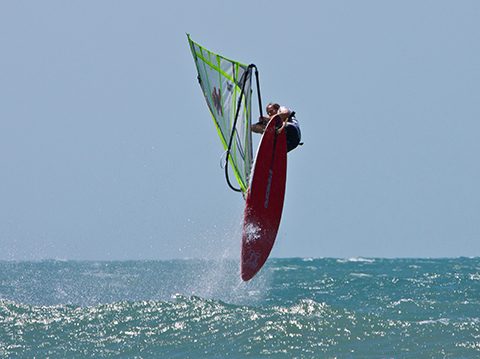
Tipping over in Jeri. Old habits die hard and my starboard loops are still a bit ‘pitch-poley.’
Rash Vest Challenge
Sometimes you just need an extra incentive to go that extra yard. While I was making the DVD ‘Learn to Loop’ a while back, I realised my speed loops could not be held up as perfect examples – they were typical ‘roll-crash-waterstarts.’
Dave White was feeling the same way about his – so one evening in the chop of Sotavento in Fuerte, we went out in 4.7 weather for a ‘who can do the first dry one’ challenge. The extra challenge was that we just wore shorts and rashies – i.e. NO impact protection. Under-rotating at that speed really stings – that’s all it took to make us pop and pull with a little more conviction.
Often a little conviction …and energy output are all that’s missing.
Make like a pro … get physical
Just last month I was standing with my looping group at the water’s edge in Jeri. It had been a good session – lots of semi rotation but not too many completed ones. I cut them some slack saying it was a bit light (5.7 weather) so hard to generate the ‘whip.’ As I said it, local boy Edvan Souza honed into view and rolled out a full planing one off a 6 inch piece of mush. “How … why … what…?” they moaned in unison.
I pointed out that Edvan is one of the best freestylers in the world. Just as gymnast Max Whitlock can almost pull a double somersault from a standing start, these pros are incredibly fit and powerful. Just the spring in their legs and the torque in their upper body is enough to rotate them without the wind. They produce huge energy out of dead situations. The part-timer can’t hope to match that – but they can match the commitment. The pros really explode into moves.
Ask yourself next time you spring off the lip, turn the body and sheet in, whether you’re really using 100% of your muscle power – or are you backing off … just in case…
To do a good one, you’ve got to really want it … I think I might have said that last month. (Last month / part 1 – is here – www.windsurf.co.uk/peter-hart-operation-rotation/
Well there ends the looping saga. Harty will be delivering more technique gold next month. In the meantime www.peter-hart.com has news of his 2017 clinic schedule and many DVDs for sale … including how to loop!


